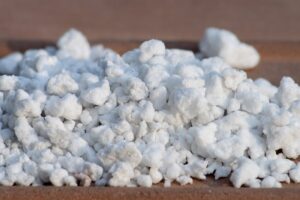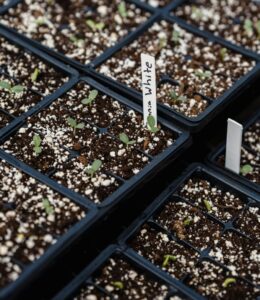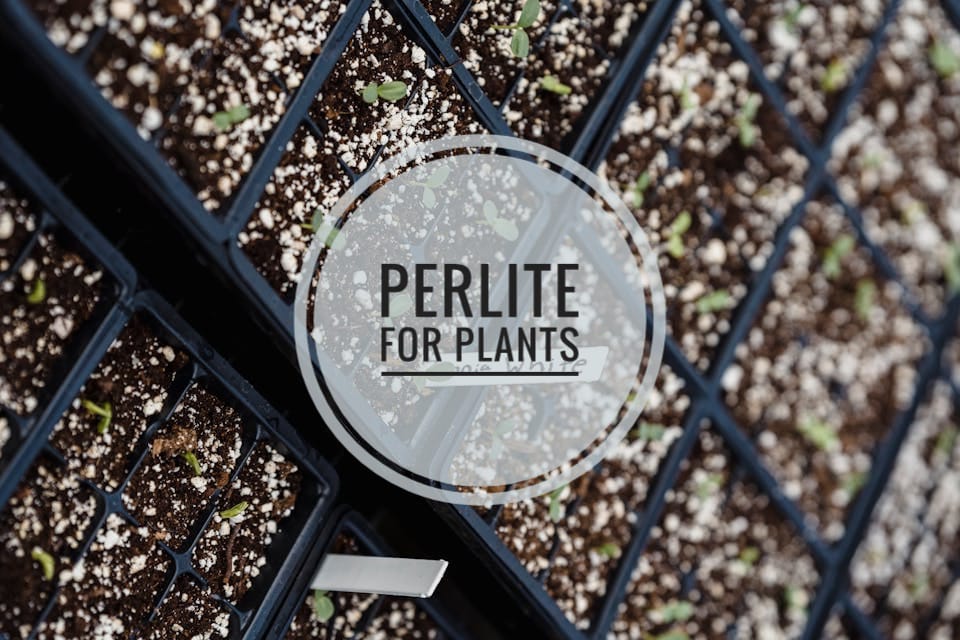Perlite for plants is a gardener’s secret weapon, improving soil drainage, aeration, and helping roots grow strong and healthy.
Perlite can transform your garden by improving soil drainage, aeration, and root health. In this post, we will explore everything you need to know about perlite and how to use it effectively in your garden.
WHAT IS PERLITE?
Perlite is a natural volcanic glass that expands when heated to high temperatures. This heating process makes it lightweight, porous, and ideal for gardening.
It is sterile, pH neutral, and free from weeds, diseases, and pests. Because of these properties, perlite is widely used in both indoor and outdoor gardening.
Perlite resembles small white popcorn-like pieces and is often mixed with soil or used in hydroponic systems. It is inorganic, so it does not decompose over time. This makes it a long-lasting addition to your garden soil.

WHY GARDENERS LOVE PERLITE
Gardeners love perlite for many reasons. First, it improves soil aeration, which allows roots to breathe. Healthy roots are the foundation of strong plants. Second, perlite improves drainage by preventing water from stagnating in the soil. This reduces root rot risk.
It also helps soil retain some moisture without becoming soggy. For seed starting, perlite is perfect because it maintains a delicate balance of moisture and air. Hydroponic growers rely on perlite as it provides support to plants without soil.
PRODUCTION OF PERLITE
Perlite is a non-renewable resource. The world reserves of perlite are estimated at 700 million tonnes.
Leading counties in perlite production are China, Turkey, Greece, USA, Armenia and Hungary, summed up to 4.6 million tonnes in 2018.
Osham hills of Patanvav, Gujarat, India are the only source of mineral Perlite in India.

DIFFERENT TYPES OF PERLITE
There are two main types of perlite available for gardening:
Horticultural Perlite
This is the most common type used by gardeners. It is lightweight and highly porous.
Coarse and Fine Perlite
Coarse perlite is best for larger pots and outdoor beds, while fine perlite is suitable for seed starting and small pots.
Some garden centers also sell “super coarse” perlite, ideal for hydroponics and bonsai cultivation. Choosing the right type is essential for the best results in your garden.
HOW PERLITE IMPROVES SOIL
Perlite changes the soil structure without adding nutrients. It creates air pockets, allowing oxygen to reach roots. This improves root growth and nutrient absorption. It also prevents soil compaction, which can suffocate plants.
In clay-heavy soil, perlite makes the soil lighter and easier to work with. In sandy soil, it increases water retention slightly, helping plants survive dry periods. Overall, perlite improves the balance of air, water, and nutrients in soil.
USING PERLITE FOR SEED STARTING
Perlite is excellent for starting seeds. Mix it with peat moss or coco coir in a 1:1 ratio to create a light, airy medium. This mix retains enough moisture to keep seeds hydrated while preventing damping-off disease.
You can also use straight perlite for very small seeds. Sprinkle seeds on moist perlite and keep it lightly covered. This method ensures good aeration and reduces the risk of fungal infections.
PERLITE IN POTTING MIXES
Perlite is a common ingredient in commercial potting mixes. It helps retain moisture, improves drainage, and keeps the soil from becoming compacted. A typical potting mix ratio could be:
Adjust the ratio depending on plant type. Succulents and cacti need more perlite for drainage, while tropical plants prefer slightly less.
PERLITE FOR HYDROPONICS
Perlite is a popular medium in hydroponic gardening. It provides excellent support to roots while allowing water and nutrients to reach them easily. Unlike soil, perlite does not decompose, so it can be reused after cleaning.
Hydroponic growers often mix perlite with vermiculite to create a balanced environment for plant roots. Perlite’s neutral pH ensures it does not alter nutrient solutions, which is crucial in hydroponics.
PERLITE IN GARDEN BEDS
Perlite can also be used in outdoor garden beds. Mix it into the soil to improve drainage in heavy clay soils. For raised beds, perlite reduces soil compaction and helps roots spread easily.
Adding perlite also helps soil retain enough moisture during dry periods without waterlogging. It is especially useful for container gardens where soil tends to dry out quickly.

WATERING AND PERLITE
Perlite helps control water in the soil. It absorbs water but releases it slowly to plant roots. This prevents overwatering and helps plants survive between watering sessions.
However, perlite does not replace good watering practices. You still need to water your plants according to their needs, but perlite acts as a buffer to maintain consistent moisture levels.
COMMON MISTAKES WITH PERLITE
Even though perlite is easy to use, gardeners sometimes make mistakes. Using too much perlite can dry out the soil because it improves drainage too much. Always follow recommended ratios.
Another mistake is not rinsing perlite before use. Some perlite contains fine dust that can float on water and cause respiratory irritation. Rinse it thoroughly before mixing into soil.
PERLITE WITH OTHER SOIL
Perlite works well with other soil amendments like vermiculite, compost, and coconut coir. Vermiculite holds more water, so mixing it with perlite creates a balanced soil that retains moisture but drains well.
Compost provides nutrients, while perlite improves aeration. Coconut coir is lightweight and renewable, making it a good partner for perlite in sustainable gardening.
STORAGE AND HANDLING
Store perlite in a dry, ventilated area to prevent it from absorbing moisture. Keep it in a sealed container or bag to avoid dust spreading in your garden.
When handling perlite, wear a mask if dust is present. This prevents inhalation of fine particles, which can irritate your lungs and eyes. Gloves are optional but recommended for sensitive skin.
BENEFITS OF USING PERLITE
The benefits of perlite are numerous:
- Improves soil drainage and aeration
- Promotes healthy root growth
- Reduces soil compaction
- Maintains consistent moisture levels
- Sterile and disease-free
- Lightweight and easy to handle
- Reusable in hydroponics
Using perlite in your garden is a simple step that can significantly improve plant health.

PERLITE VS VERMICULITE
Perlite and vermiculite are often compared, but they serve different purposes. Perlite improves drainage and aeration, while vermiculite holds water and nutrients.
For sandy soil, vermiculite is better to increase water retention. For clay soil, perlite is better to improve drainage. Many gardeners use both to create a balanced potting medium.
PERLITE FOR SPECIFIC PLANTS
Some plants benefit more from perlite than others. Succulents, cacti, orchids, and bonsai plants prefer soil mixed with a high amount of perlite. Tropical plants benefit from a moderate amount.
Seedlings and cuttings also thrive in perlite because it prevents damping-off and promotes root formation. Gardeners experimenting with hydroponics often use perlite as the primary growing medium.
WHERE TO BUY PERLITE
Perlite is widely available at garden centers, nurseries, and online stores. It is sold in small bags for home gardeners or large bags for commercial use.
Always check the type and grade of perlite before purchasing. Horticultural-grade perlite is ideal for most gardening applications, while coarse perlite is suitable for large containers and outdoor beds.

FINAL THOUGHTS ON PERLITE
Perlite is a simple, affordable, and versatile gardening tool. It improves soil structure, promotes root health, and helps plants grow strong. Beginners and experts alike can benefit from using perlite.
Incorporating perlite into your soil or potting mix is easy and highly effective. It may seem small and simple, but its impact on plant growth is significant. Healthy soil means healthy plants, and perlite helps achieve that.
